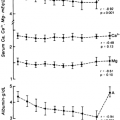PHYSICAL EXAMINATION AND MENSURATION
Part of “CHAPTER 43 – ENDOCRINE OPHTHALMOPATHY“
The purpose of physical examination and mensuration in orbital disease initially is to establish the position of the eyes relative to each other and to the bony landmarks of the orbit. Orbital disease processes usually affect only the soft tissue of the orbit so that, with very few exceptions, the bony margins remain constant. Thus, measuring devices relate the globe to the fixed bony points of reference.
Physical examination of the exophthalmic patient begins with inspection, but direct viewing of the subject can be misleading. The best method of determining if proptosis exists is to stand behind the seated patient and evaluate the position of the eyes by looking down over the brows. The patient is then placed in a supine position, and the position of the eyes is reassessed while the physician is standing above and behind the patient. In normal people, the globe sinks back when the patient is recumbent. In such circumstances, exophthalmometric measurements are reduced from the erect position by 1 to 3 mm.49 This retraction does not occur in the seemingly unaffected eye of patients with Graves disease even though the exophthalmos may appear to be unilateral. However, in cases of exophthalmos resulting from a unilateral orbital tumor, the normal postural difference of the unaffected eye is noted; therefore, this may be used as a method of differential diagnosis between seemingly unilateral endocrine exophthalmos and a unilateral orbital tumor.
Stay updated, free articles. Join our Telegram channel

Full access? Get Clinical Tree





